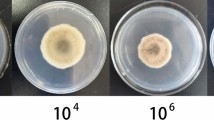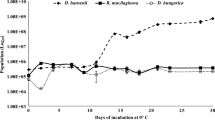Abstract
Microorganisms, including native yeasts, are abundant in vineyard fields. Herein, we studied the possibility of using vineyard-derived wild yeast as a microbial pesticide against Botrytis cinerea, a pathogen that causes grape gray mold disease, to boost the initial alcohol production of spontaneously fermented wine. We identified the Saccharomyces cerevisiae strain KONDO170908, which showed the most effective antifungal activity in an ex vivo yeast dripping experiment on grape berries. This strain was utilized in an in vivo spray test on grape bunches in vineyard fields and was proven to significantly suppress gray mold disease on the grape berries in test plot #16 when the yeast was sprayed during both the flowering and ripening periods (morbidity 11.2% against 15.3% of the control plot, χ2 test, p < 0.0001). However, in test plot #17, spraying the yeast during only the ripening period had no effect (morbidity 16.3%). The grapes from each test plot were also submitted for spontaneous wine fermentation. Alcoholic fermentation of the grapes from test plot #16 provided the most active bubbling of CO2 gas and the highest ethanol production and colony counts over seven days of fermentation. Unique changes in the different strains of S. cerevisiae among the plots were observed throughout the early fermentation stage. Thus, yeast spraying during the flowering period might trigger modification of the entire microbiota and could ultimately contribute to promoting alcohol production in the spontaneously fermented wine, although it decreased the grape yield by 20%.







Similar content being viewed by others
References
Cabañas CM, Hernández A, Martínez A, Tejero P, Vázquez-Hernández M, Martín A, Ruiz-Moyano S (2020) Control of Penicillium glabrum by indigenous antagonistic yeast from vineyards. Foods 9:1864
Calvo-Garrido C, Elmer PAG, Viñas I, Usall J, Bartra E, Teixidó N (2013) Biological control of botrytis bunch rot in organic wine grapes with the yeast antagonist Candida sake CPA-1. Plant Pathol 62:510–519
Cañamás TP, Viñas I, Torres R, Usall J, Solsona C, Teixidó N (2011) Field applications of improved formulations of Candida sake CPA-1 for control of Botrytis cinerea in grapes. Biol Control 56:150–158
Chen PH, Chen RY, Chou JY (2018) Screening and evaluation of yeast antagonists for biological control of Botrytis cinerea on strawberry fruits. Mycobiology 46:33–46
Ciani M, Comitini F, Mannazzu I, Domizio P (2010) Controlled mixed culture fermentation: a new perspective on the use of non-Saccharomyces yeasts in winemaking. FEMS Yeast Res 10:123–133
Cordero-Bueso G, Mangieri N, Maghradze D, Foschino R, Valdetara F, Cantoral JM, Vigentini I (2017) Wild grape-associated yeasts as promising biocontrol agents against Vitis vinifera fungal pathogens. Front Microbiol 8:2025
De Simone N, Pace B, Grieco F, Chimienti M, Tyibilika V, Santoro V, Capozzi V, Colelli G, Spano G, Russo P (2020) Botrytis cinerea and table grapes: a review of the main physical, chemical, and bio-based control treatments in post-harvest. Foods 9:1138
Freimoser FM, Rueda-Mejia MP, Tilocca B, Migheli Q (2019) Biocontrol yeasts: mechanisms and applications. World J Microbiol Biotechnol 35:154
Hall ME, Loeb GM, Cadle-Davidson L, Evans KJ, Wilcox WF (2018) Grape sour rot: a four-way interaction involving the host, yeast, acetic acid bacteria, and insects. Phytopathology 108:1429–1442
Hudagula MN, Takahashi S, Yoshida KR, Yamaguchi A (2021) Screening of wild yeasts inhabiting vineyards as microbial pesticide candidates against grape gray mold disease. Nippon Shokuhin Kagaku Kogaku Kaishi 68:328–338
Ji X, Li J, Meng Z, Zhang S, Dong B, Qiao K (2019) Synergistic effect of combined application of a new fungicide fluopimomide with a biocontrol agent Bacillus methylotrophicus TA-1 for management of gray mold in tomato. Plant Dis 103:1991–1997
Keller M, Viret O, Cole FM (2003) Botrytis cinerea infection in grape flowers: defense reaction, latency, and disease expression. Phytopathology 93:316–322
Lamont JR, Wilkins O, Bywater-Ekegärd M, Smith DL (2017) From yogurt to yield: potential applications of lactic acid bacteria in plant production. Soil Biol Biochem 111:1–9
Leroux P, Fritz R, Debieu D, Albertini C, Lanen C, Bach J, Gredt M, Chapeland F (2002) Mechanisms of resistance to fungicides in field strains of Botrytis cinerea. Pest Manag Sci 58:876–888
Marisol V, Felipe G, Nelson Z, Maritza T (2012) Isolation and selection of epiphytic yeast for biocontrol of Botrytis cinerea Pers. on table grapes. Chil J Agric Res 72:332–337
Nagai H, Miyake N, Kato S, Maekawa D, Inoue Y, Takikawa Y (2017) Improved control of black rot of broccoli caused by Xanthomonas campestris pv. campestris using a bacteriophage and a nonpathogenic Xanthomonas sp. strain. J Gen Plant Pathol 83:373–381
Nally MC, Pesce VM, Maturano YP, Muñoz CJ, Combina M, Toro ME, de Figueroa LIC, Vazquez F (2012) Biocontrol of Botrytis cinerea in table grapes by non-pathogenic indigenous Saccharomyces cerevisiae yeasts isolated from viticultural environments in Argentina. Postharvest Biol Technol 64:40–48
Nigro F, Schena L, Ligorio A, Pentimone I, Ippolito A, Salerno MG (2006) Control of table grape storage rots by pre-harvest applications of salts. Postharvest Biol Technol 42:142–149
Pearson RC, Taschenberg EF (1980) Benomyl-resistant strains of Uncinula necator on grapes. Plant Dis 64:677–680
Pretscher J, Fischkal T, Branscheidt S, Jäger L, Kahl S, Schlander M, Thines E, Claus H (2018) Yeasts from different habitats and their potential as biocontrol agents. Fermentation 4:31
Rogers D, Bevan E (1978) Group classification of killer yeasts based on cross-reactions between strains of different species and origin. J Gen Microbiol 105:199–202
Sugawara R, Yamada S, Tu Z, Sugawara A, Suzuki K, Hoshiba T, Eisaka S, Yamaguchi A (2016) Rapid and reliable species identification of wild mushrooms by matrix assisted laser desorption/ionization time of flight mass spectrometry (MALDI-TOF MS). Anal Chim Acta 934:163–169
Tu Z, Yamada S, Hu D, Ito Y, Iwasaki T, Yamaguchi A (2019) Microbial diversity in the edible gall on white bamboo formed by the interaction between Ustilago esculenta and Zizania latifolia. Curr Microbiol 76:824–834
Williamson B, Tudzynski B, Tudzynski P, van Kan JA (2007) Botrytis cinerea: the cause of grey mould disease. Mol Plant Pathol 8:561–580
Yarden O, Katan T (1993) Mutations leading to substitutions at amino acids 198 and 200 of beta-tubulin that correlate with benomyl-resistance phenotypes of field strains of Botrytis cinerea. Phytopathology 83:1478–1483
Acknowledgements
The authors thank Ms. Kurumi Kameda, Ms. Ayami Fujimaru, Ms. Rio Sugai, Ms. Ayane Sato, Ms. Ayaka Kodama, Ms. Mizuki Okada (Rakuno Gakuen University) and Ms. Tomoko Kondo (Kurisawa Wines) for their technical support and encouragement through this study.
Funding
This study was supported in part by Grants-in-Aid for Regional R&D Proposal-Based Program from Northern Advancement Center for Science & Technology of Hokkaido Japan.
Author information
Authors and Affiliations
Contributions
HH, RK, and AY conceived the study. HH and AY drafted the manuscript. HH colledted the data. NM, NM, ST, KY, and RK provided technical supports. KO and YF provided a critical revision of the manuscript. All the authors contributed equally to the manuscript and read and approved the final version of the manuscript.
Corresponding author
Ethics declarations
Competing interests
The authors declare no conflicts of interest.
Additional information
Publisher's Note
Springer Nature remains neutral with regard to jurisdictional claims in published maps and institutional affiliations.
Rights and permissions
Springer Nature or its licensor (e.g. a society or other partner) holds exclusive rights to this article under a publishing agreement with the author(s) or other rightsholder(s); author self-archiving of the accepted manuscript version of this article is solely governed by the terms of such publishing agreement and applicable law.
About this article
Cite this article
Hu, D., Maeno, N., Minami, N. et al. Antifungal activities of vineyard-habitat wild yeast for grape gray-mold disease and its effects on spontaneous winemaking. Antonie van Leeuwenhoek 117, 27 (2024). https://doi.org/10.1007/s10482-023-01922-0
Received:
Accepted:
Published:
DOI: https://doi.org/10.1007/s10482-023-01922-0




